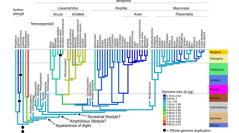

 Comptes Rendus Palevol
15 (1-2) - Pages 65-73
Comptes Rendus Palevol
15 (1-2) - Pages 65-73Genome size spans over a 300-fold range among vertebrates (132 pg for Protopterus aethiopicus, the marbled lungfish, and 0.35 pg for Tetraodon nigroviridis, the green spotted pufferfish). While phylogenetic analysis of genome size has helped clarify how this variation evolved in multiple tetrapod groups, the ancestral tetrapod condition still remains poorly characterized, and this obscures our understanding of character state polarity and macroevolutionary trends in genome size. To address this problem, we used phylogenetic comparative methods to analyze paleohistological data from eight taxa of the Middle and Late Paleozoic to the Early Mesozoic: Eusthenopteron, Ichthyostega, Acheloma, Eryops, Trimerorhachis, Wetlugasaurus , an unidentified dissorophoid, and Chroniosaurus. Five other extinct taxa were included from previous studies to better frame our results, including Marmorerpeton, Cardiocephalus, Diplocaulus, an unidentified basal sauropsid, and Mycterosaurus. We augmented a previously reported histological and genome size data set (including data from 14 lissamphibians, three testudines, Sphenodon, five squamates, two crocodilians, 11 birds, and 22 mammals) with genome size and histological data from extant Latimeria and three extant actinopterygians. Our results suggest that all eight of the newly analyzed extinct taxa had genome sizes ranging between 3.2 and 3.9 pg. These results imply that basal tetrapods had genome sizes (and underlying genomic architectures) similar to extant mammals and lepidosaurs. We find no major shifts in genome size during the tetrapod water-to-land transition. Our analysis suggests that Eusthenopteron and Ichthyostega had genome sizes well within the range of extant actinopterygians and Latimeria, despite several whole-genome duplications in actinopterygians.
Tetrapods, Lissamphibians, Sarcopterygians, Paleogenomics, Phylogenetic comparative methods